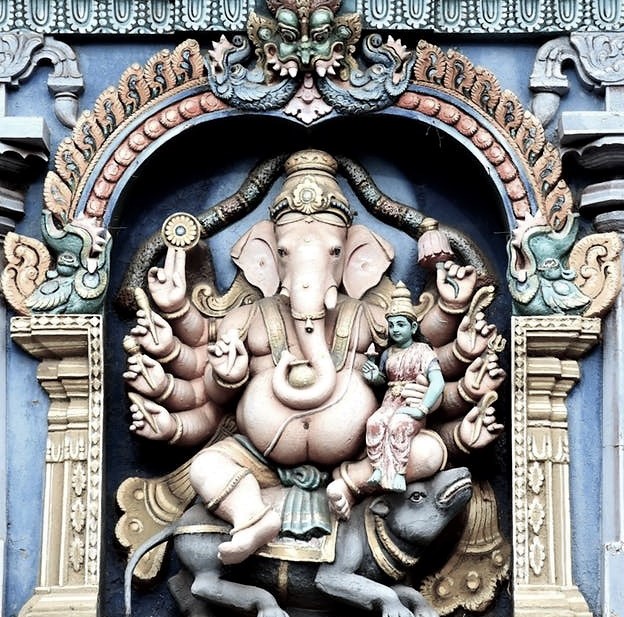- Special FeaturesFoundation Year1970Sthala TreeTheerthamRathamArchitectureVesara styleOther Speciality
- Sthala Puran
Chhatarpur Temple is located in a downtown area in south of Delhi - Chhatarpur, India. This temple is dedicated to Goddess, Katyayani.
The story of this Shaktipeeth is woven inextricably around the life of its Founder the great Saint Shree Durga- Charan-anuragi Baba Sant Nagpal, who was so full of humility that in his lifetime he did not permit his disciples to glorify his name in any manner. ‘Baba’ (to his devotees) was born in Karnataka on the auspicious full-moon day of the Holi festival in 1981 of Vikram Samvat (corresponding to Tuesday the 10th March). He lost his parents at a very tender age. It was at the time of cremation of his mother that an unknown lady took the grieving child to the adjacent Temple of Mother Goddess and told him that SHE was the real universal Mother who would always remain with him.
Ever since that moment, the Divine Mother gave him shelter in her own lap. On his part also, it has been an unquestioned dedication and total surrender to the Divine Mother in thought, word, and deed. For Baba, She was a living reality with whom he remained in communication and never did anything without seeking Her permission and blessings.
- Architecture
The entire temple complex spread over 60 acres (24.3 ha), has over 20 small and large temples divided in three different complexes. The main deity in the temple is Goddess Katyayani, a part of Navadurga, the nine forms of Hindu goddess Durga or Shakti, worshipped during the Navratri celebrations.
This temple is totally constructed from marble and on all the facets there is jaali (perforated stone or latticed screen) work. It can be classified a vesara style of architecture.
A side shrine within the main temple houses a shrine of Goddess Katyayani (Durga), which opens only during the bi-annual Navratri season, when thousands of people throng the premises for darshan. One nearby room has been made as living room with tables and chairs made in silver, and another regarded as the Shayan Kaksha (Bed Room), where a bed, dressing table and table are carved in silver. This shrine opens on a large satsang or prayer hall, where religious discourses and bhajans, (religious songs) are held. Just at the entrance to the main temple, stand an old tree, where devotees tie holy threads for wish fulfillment. Another shrine of Goddess Durga is open to devotees morning to evening, it lies above the shrines dedicated to Radha Krishna, and Lord Ganesh.
Apart from this the complex also has other temples dedicated to Lord Rama, Lord Ganesha and Lord Shiva. The temples have been built in both South and North Indian style of temple architecture.
- Alankar of Deity
- Prayers and BenefitsSpecial Vratas and PrayersOfferings to DeityStotras and Mantras
Durgati Nashini, Durga Jai Jai, Kaal Vinashini Kaali Jai Jai. Uma Rama Brahmani Jai Jai, Radha Rukmani Sita Jai Jai.
- FestivalsNavratraThe mandir celebrates Vasant Chaitra Navratras (New year of the Hindu Calendar) in March/April every year on the occasion of the birthday of Lord Rama. The celebrations start with Kumbhabhishek i.e. holy bath of Maa Katyayani a few days before the start of the Navratras as per tradition started by Babaji. This is followed by Delhi Darshan when offerings consisting of lehngas/sarees, chunnis, fruits, sweets, garlands and cash are sent to 41 temples, dargahs etc in the city. Among the daily events during Navratras are ceremonies such as Havan, Rudhrabhishek, Durga Saptsati Path, Ramayan Path, Rath Puja, Lungar Puja etc. The Mandir is open round the clock during Navratras.MahashivratriMahashivratri is celebrated every year in the temple on the 14th day of the Hindu month of Falgun (February-March). The Mandir Trust provides all the pooja materials like Flowers, Gangajal, Chandan, Milk, Bhang, Datura, Fruits etc needed for the Rudhrabhishek of Lord Shiva free of cost to all the devotees.Krishna JanmashtamiThis festival is celebrated on the Bhadrapad Ashtami (8th day) of the Hindu month of Bhadon (August/September). At the Shaktipeeth Mandir, different tableaux are decorated to depict the various aspects of Lord Krishna’s life. These tableaux attract a large number of devotees.Babaji’s BirthdayThis auspicious day is celebrated on the full moon day in February/March i.e. in the Hindu month of Fagun. In the morning, Babaji’s statue is given a holy bath (Kumbhabhishek) and there is a continuous recital of the following mantra for 24 hours.
- Sodasha Upcharas
- Prasadhas
- Social ActivitiesAnnadhanMarriageEar BoringHead ShaveDanaasEducation FacilitiesSocial DrivesOther Activities
- Arjita Sevatest
- Tags

